24 September 2025
I’ve read that there are no fewer than eighteen ways to say “hello” in Japanese, which means I’m visiting Japan eighteen steps behind. When I learned the Russian alphabet, at least I could puzzle out the words on a sign—even if I couldn’t pronounce a single one correctly. Japanese, however, covers a whole different universe. Then, add the usage of Chinese characters alongside Japanese characters. Q

I don’t have the faintest clue what the characters mean, let alone how to say them. So for now, my linguistic arsenal in Tokyo consists of a polite bow, “konnichiwa,” and smile—which, I hope, is one of those eighteen greetings.
Japanese writing isn’t just one system but three. Hiragana and Katakana are both phonetic scripts, with each character standing for a sound. Hiragana shows up in grammar and native Japanese words, while Katakana is used mostly for foreign loanwords.
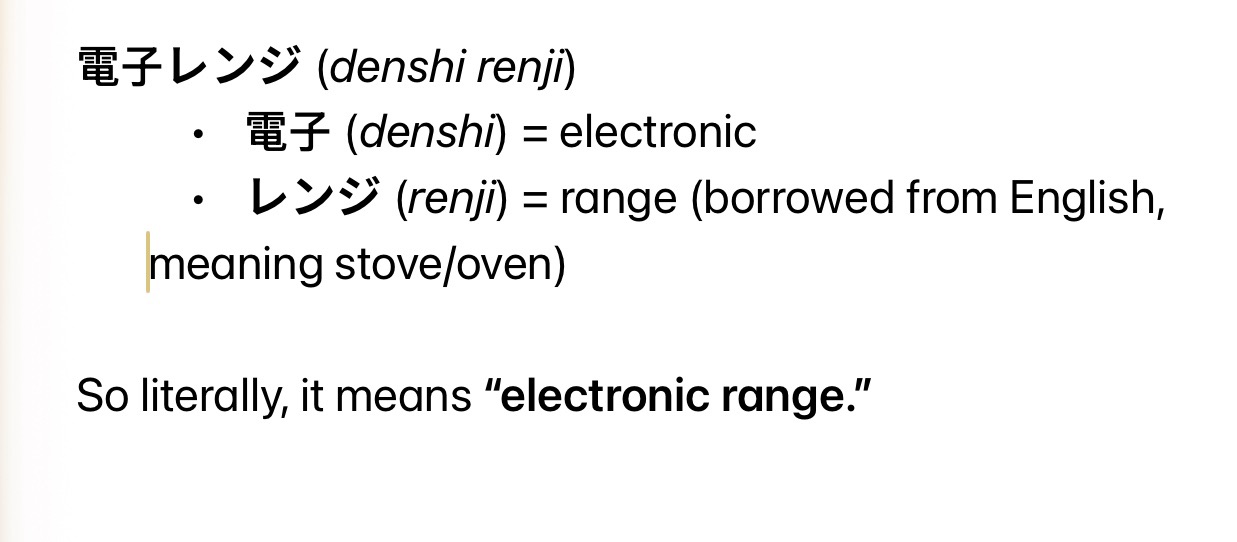
That last part gives me a little hope—maybe I’ll spot a word or two that looks familiar, borrowed from English. Still, unless my brain can sort through squiggles, curves, and straight lines, I’ll be sticking to my trusty “konnichiwa” and “arigatō.”
Morning Views and Cinematic Memories
My Japanese breakfast is simple: an electric kettle and packets of instant coffee. From my window, though, the view is anything but ordinary. Above the skyline rises the iconic Tokyo Tower, completed in 1958 as both a communications hub and an observation tower. At nearly 1,100 feet, it actually stands taller than the Eiffel Tower which inspired it, thanks to lightweight yet stronger steel. Still, when I see its red-and-white frame, I don’t think of Paris—I think of monster movies.
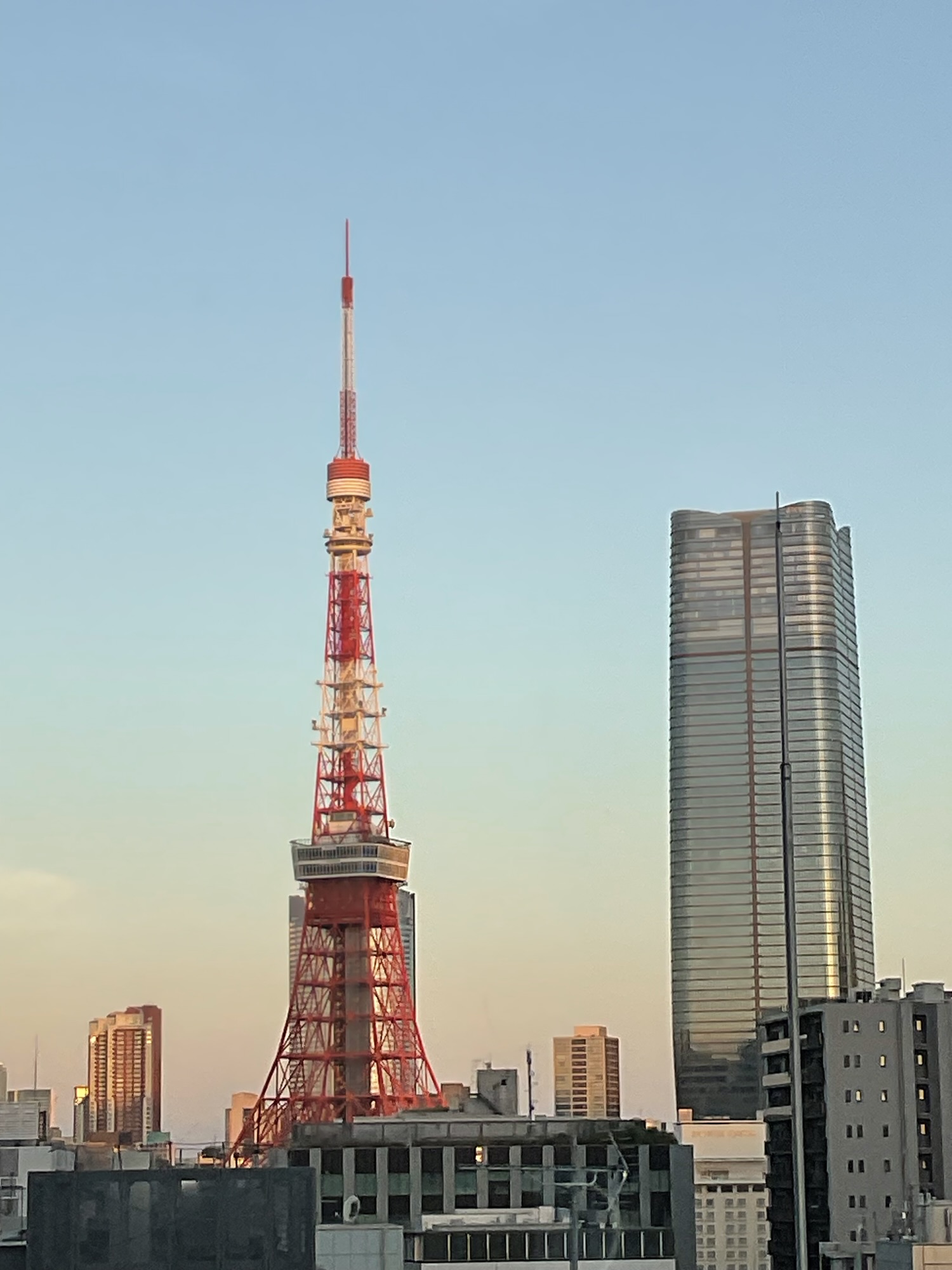
Tokyo Tower remains a star on the silver screen, especially in the Godzilla universe. Over the years it has been battered by King Ghidorah, blasted by Godzilla’s atomic breath, and even reduced to rubble by his heat ray.
In 1961, the giant moth Mothra spun her cocoon on its frame before making her dramatic debut. If time allows, I may follow her lead—though without the cocoon—and climb the tower for its sweeping views.
Gardens – Good Anytime During My Day
Caffeine-fortified, I set out from my hotel toward Kyu-Shiba-Rikyu Gardens. Tokyo hosts countless gardens and parks, each offering its own pocket of calm amid the city’s bustle.
Just a short walk beyond the Hamamatsuchō Station, this Edo-period landscape garden is one of the oldest in Tokyo, dating back to the 17th century. Unlike some of the city’s more famous green spaces, Kyu-Shiba-Rikyu is far less crowded.
The Edo period (also called the Tokugawa period) occurred from 1603 to 1868. It began with the Tokugawa shogunate in Edo (present-day Tokyo) and ended when Japan opened to the outside world and the Meiji Restoration began. This was acknowledged as a time of peace and stability after centuries of civil war. Designed during this time for feudal lords (daimyō) as private retreats, gardens like Kyu-Shiba-Rikyu showcased harmony between water, stone, and plants.
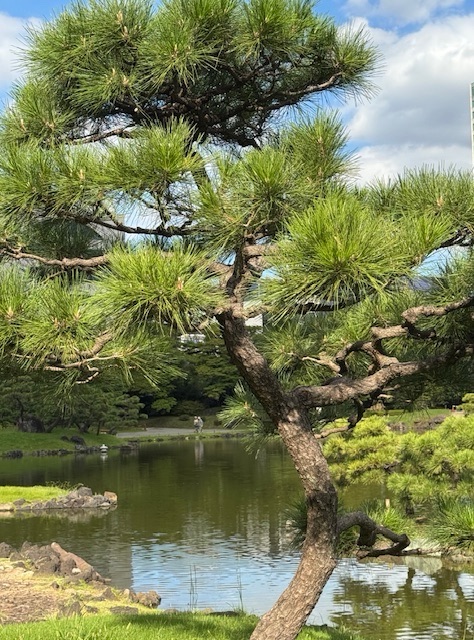
Inside, carefully manicured paths wind around a central pond, complete with little islands, stone bridges, and the occasional carp looking for food. Sculpted pines and flowers frame the water, while the modern skyline looms beyond, creating a striking contrast between old and new.
It’s easy to imagine samurai and nobles strolling these same paths, finding the same serenity I do now—though probably without the morning coffee.
Taking the Metro Challenge
From the calm of the garden, it’s a short walk to Takeshiba Station, where the rustle of pine trees is replaced by the clatter of trains and the hum of commuters. I hop onto the Yurikamome line. It is early and most sites don’t open until 9 so I ride several stops to Akiake-tennis-no-mori Station.
I can handle the English alphabet just fine—but throw a sign at me in Japanese characters, and suddenly my options become reduced to two: frantic pointing or fumbling with Google Translate on my phone. Neither is ideal when standing like a confused obstacle in the middle of a busy station.
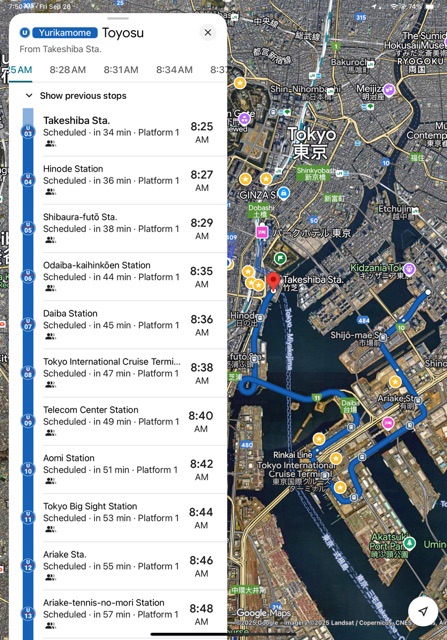
However, Google Maps is a life-saver and details every stop on the line. Excellent. Combined with the digital Suica card in my AppleWallet, transportation is easy.
My destination is Odaiba.
Exploring DiverCity
DiverCity was built as part of the development of Odaiba, a man-made island in Tokyo Bay created by land reclamation. Starting in the mid-20th century, huge amounts of soil and sand were brought in to expand the small defensive islands that had been built in the 1800s.
Over time, these expanded into today’s Odaiba District, designed as a shopping and entertainment mecca. One finds Odaiba Beach, lots of interactive attractions, and a mix of pop icons and Tokyo-style fun. Think Disneyland on modern-day steroids.
I ignore the shopping and seek out some of the more iconic attractions.
Gundam Statues
DiverCity’s signature attraction is the towering Unicorn Gundam statue installed as a symbol of futuristic Odaiba. Its foundation rests on reinforced ground reclaimed from the bay, designed to withstand both heavy use and Tokyo’s seismic activity. For anime fans, the statue is a must-see.
Anime represents a style of animation that originated in Japan and has grown into a worldwide cultural phenomenon. But Japanese anime embodies more than just cartoons. Think colorful characters, epic stories, and worlds that range from everyday life to full-on fantasy chaos. This from the city that brought us Godzilla and Mothra.
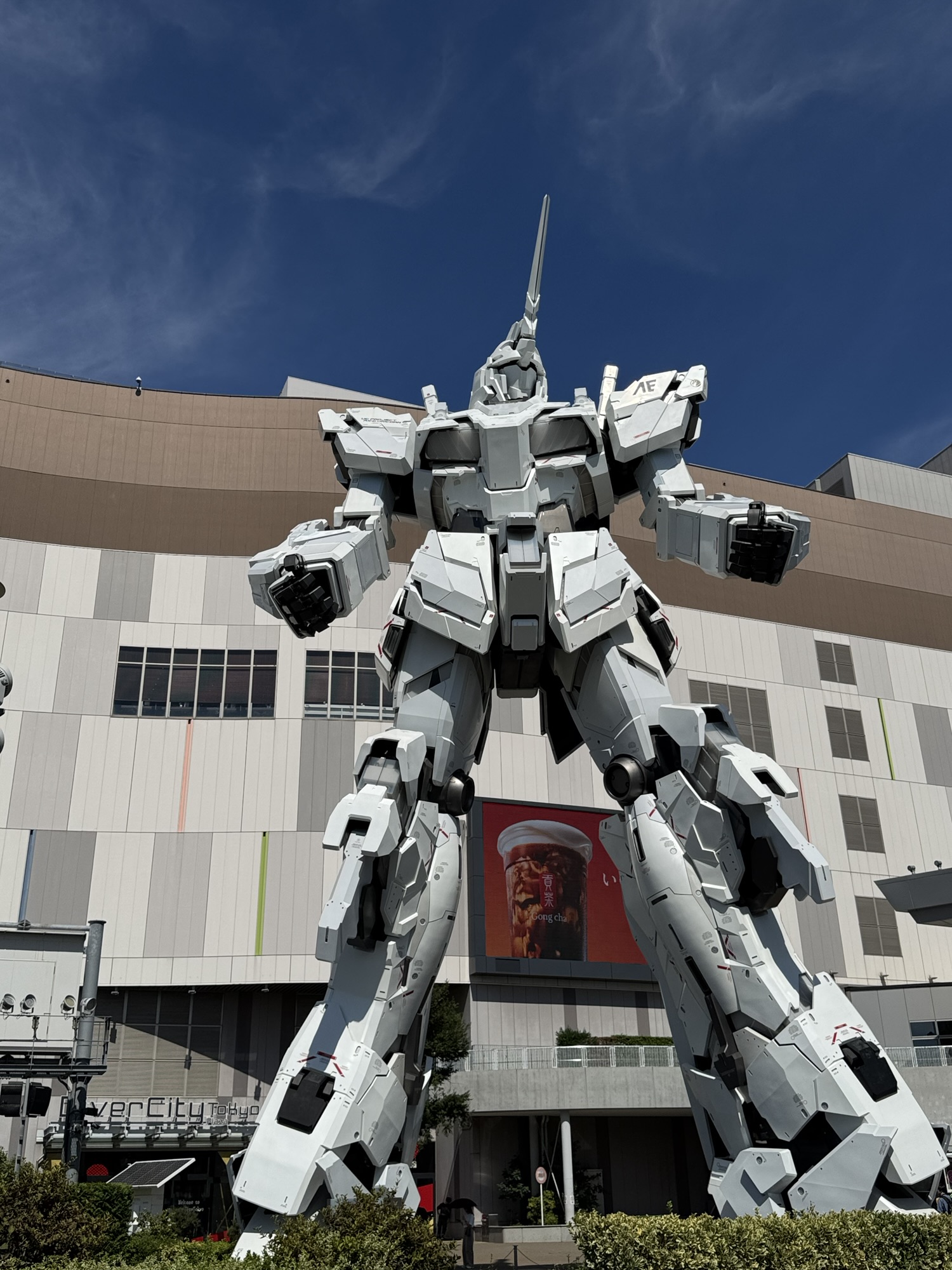
Gundam stands an impressive 59 feet, a jaw-dropping life-sized replica of the RX-0 Unicorn Gundam from the popular Mobile Suit Gundam anime series. The statue consists of intricate detail, from its armor panels and mechanical joints to its glowing eyes and chest. About every 30 minutes, it briefly transforms, moving its parts and opening its eyes. It’s not a spectacular show, but it is fun. At night, LED lights make it glow like a giant, futuristic guardian, prepared to stomp off the plaza and start fighting kaiju.
Tucked nearby is a less impressive, but oddly interesting statue.
Statue of Liberty
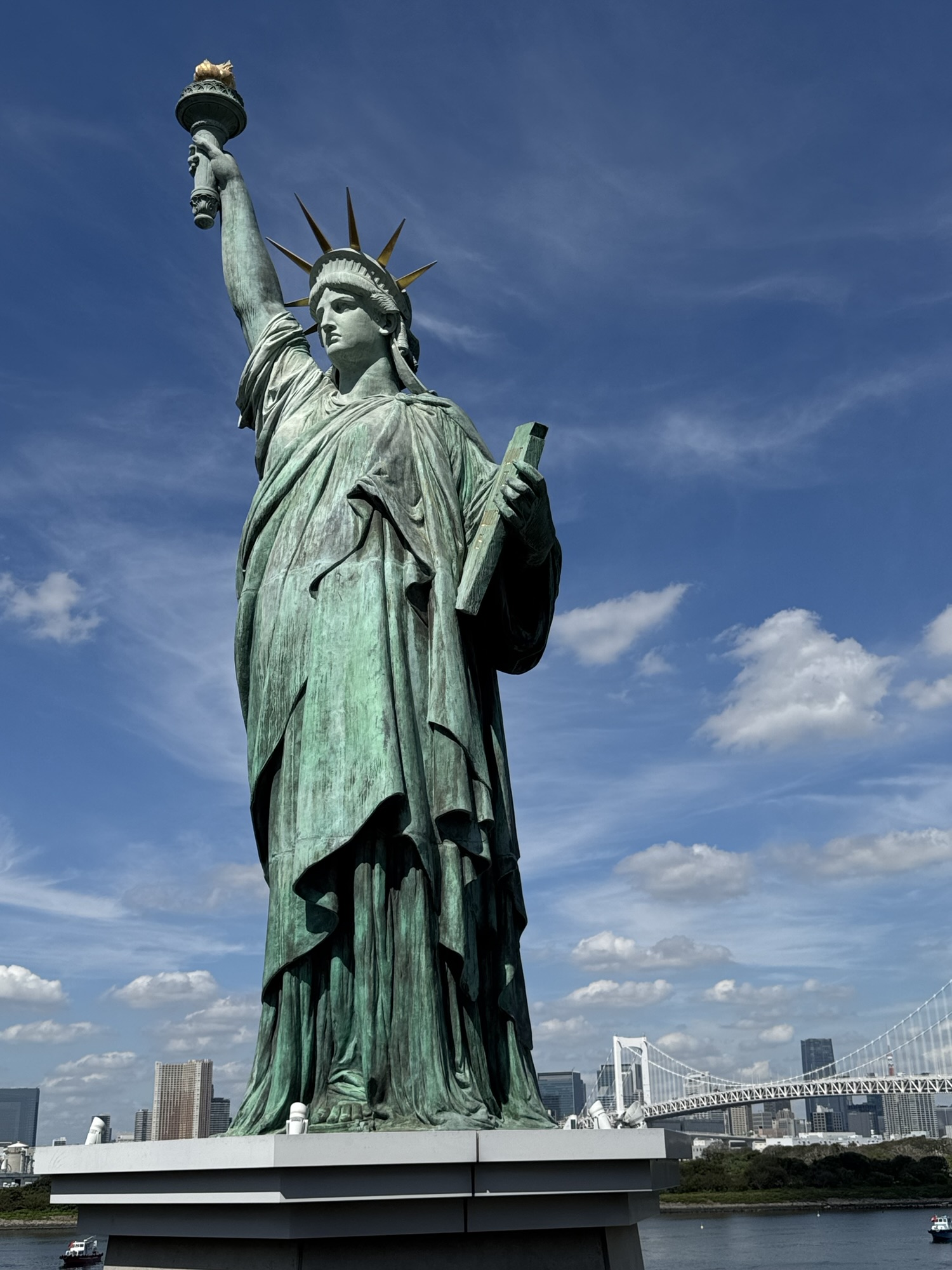
This statue is a mini-Statue of Liberty version of the iconic New York landmark, standing proudly at about 40 feet (New York’s towers 305′). Installed as part of Odaiba’s original development concept in the 1990s, it exudes a rather cheeky nod to the West and a reminder of Odaiba’s mix of Japanese creativity and global pop culture.
In some films, like 1994’s Godzilla vs. SpaceGodzilla, the statue appeared in scenes of cityscapes under attack as giant monsters wreaked havoc. While it doesn’t have the starring role of Tokyo Tower or the full-size Gundam, it adds a fun element to Odaiba’s pop-culture landscape. Its location also gives one great photo opportunities of Rainbow Bridge and Tokyo Bay.
Museums of Odaiba
Miraikan
The National Museum of Emerging Science and Innovation, also known as Miraikan, is a must-visit for anyone curious about cutting edge technology and science. Entering its doors seems like stepping into the future. From exploring Earth’s changing climate to learning about the latest advances in medicine and engineering, the museum is mind-expanding and fun.
From creepy little boys to humanoid robots like ASIMO to hands-on exhibits about space, AI, and the environment, it’s a playground for anyone curious about how the world works (and where it’s headed). I could poke, prod, and control the displays, which made it feel more like a science amusement park than a museum.
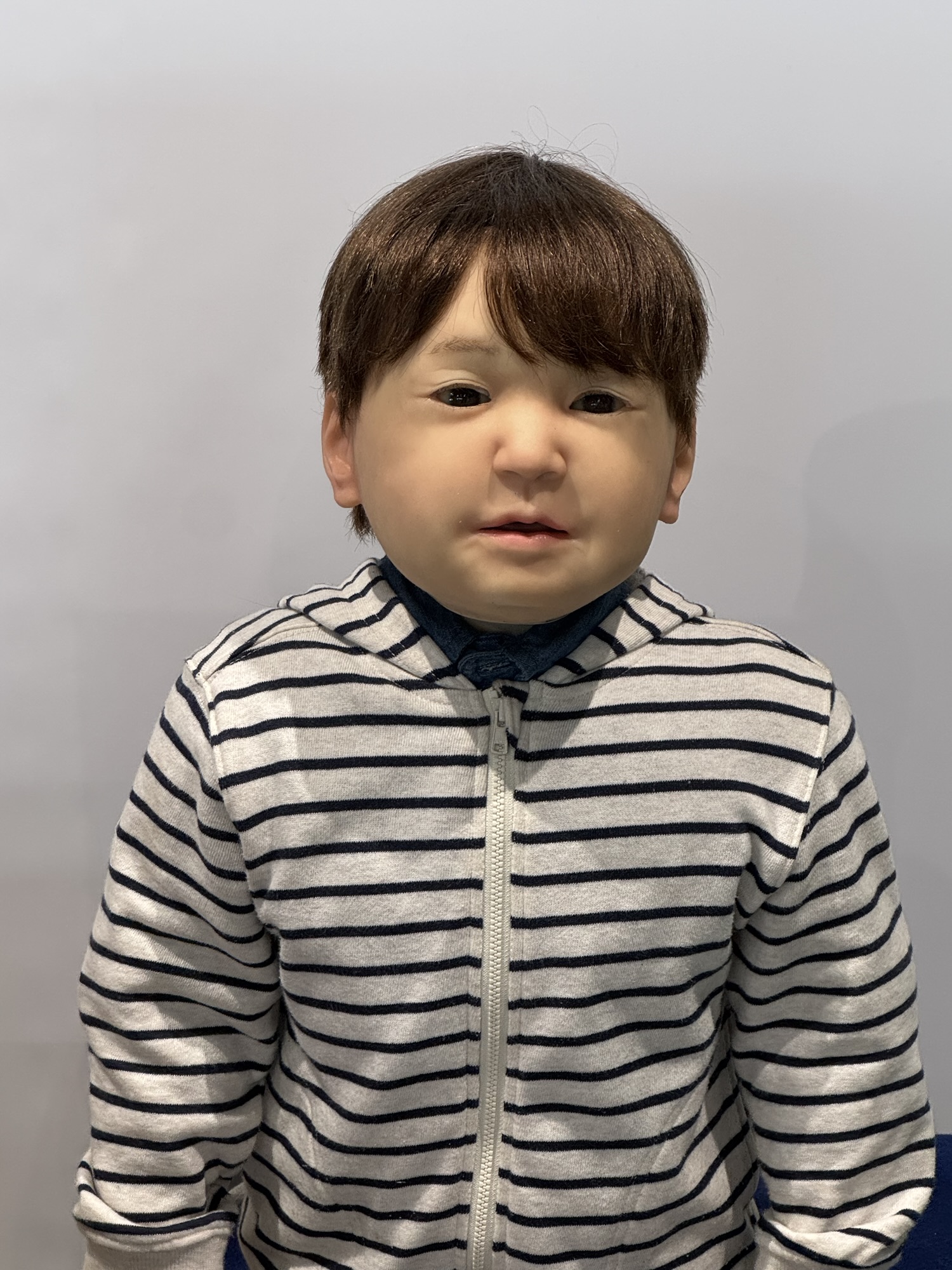
Small Worlds Tokyo
A second museum, a short walk from Gundam, is Small Worlds Tokyo. A delightful miniature museum, it’s one of the largest of its kind in Asia. It features meticulously crafted 1:80 scale miniatures of various scenes, including space centers, global villages, Kansai International Airport, and themed areas like Sailor Moon and Evangelion.
One enjoys gobs of buttons to push resulting in rather cheesy animations. Sound effects range from ducks quacking to guns firing. The whole museum reminds me of the strange conglomeration of stuff your eccentric old auntie collected. Seems an ideal stop for young kids ages 6-10
Among the best displays is the Kansai International Airport model, the airport in Osaka Bay and my departure airport when leaving Japan in a few weeks. The miniature accompanied by appropriate sound effects, allowed me to observe planes taxiing, taking off and landing (flying in and out of a hole in the wall). The remarkable detail includes miniature ground crews, baggage handling, and even realistic lighting that shifts from day to night.
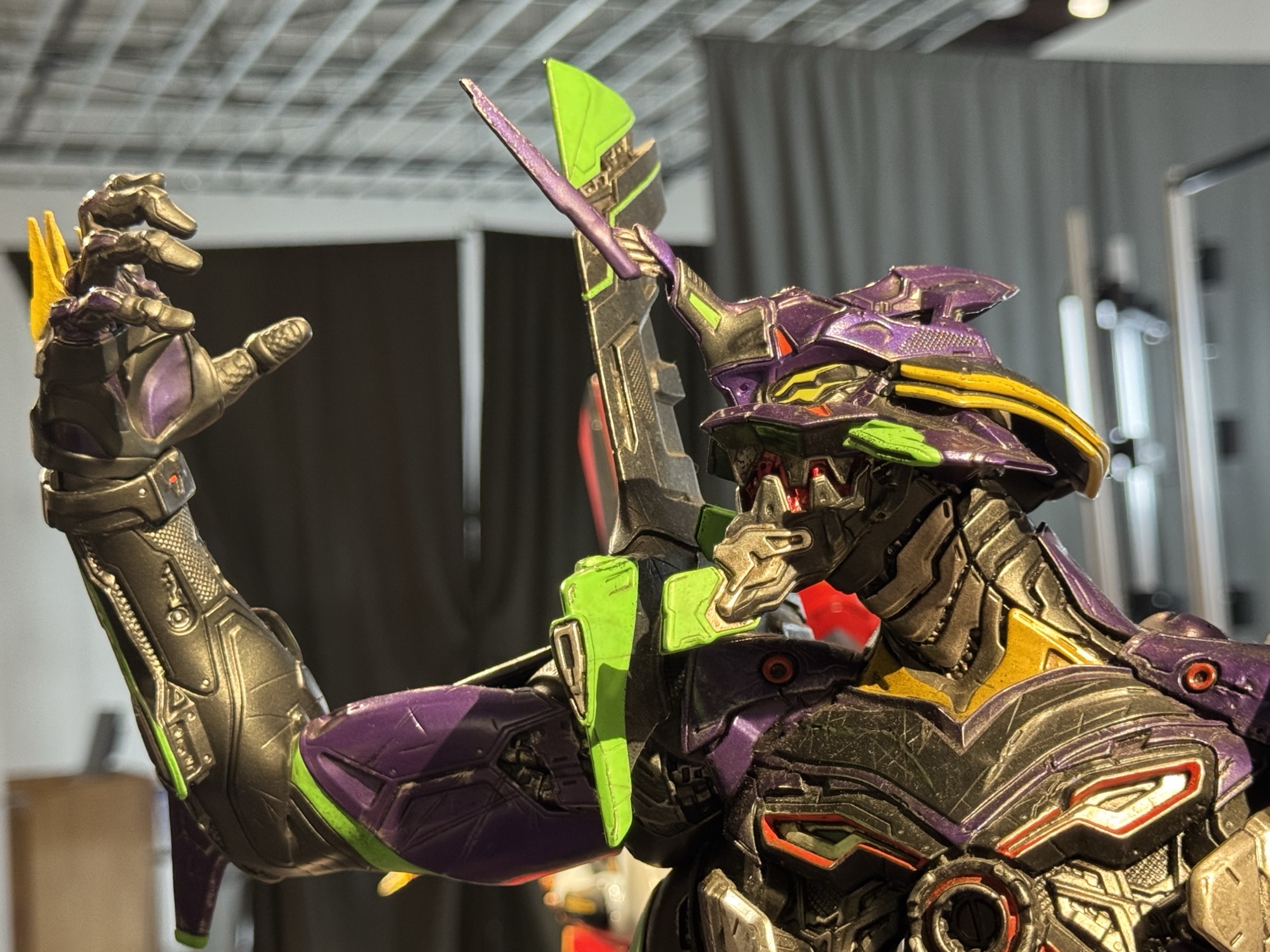
Another notable exhibit, and a hit for the older kids, features the Evangelion area, a detailed miniature of Tokyo-III, the fictional city from the anime series. The exhibit includes moving elements, such as the transformation of the city and the launch of the Evangelion giant humanoid robots.
For visitors interested in fantasy aesthetics, the Global Village offers a journey through miniature villages featuring dragons, airships, and glowing mines.
Lookouts and Views
Odaiba offers several excellent viewpoints of Tokyo’s skyline and its scenic waterfront. While the views at night are spectacular, daytime views deserve a pause. The Telecom Center’s 21st floor provides an observation deck some 324’ above ground offering sweeping views of Tokyo, including Tokyo Tower, Tokyo Skytree, downtown Shinjuku, and Shinagawa Wharf. There is a fee but I read the views, free massage chairs and binoculars are worth it. Unfortunately, its hours are limited so I will seek my views elsewhere.
Whether at the specific Lookouts, the beach, seaside parks or bayside decks, panoramas of Tokyo city, Tokyo Bay and the Rainbow Bridge should not be missed. In fact, views and breezes are best from the bridge.
Rainbow Bridge
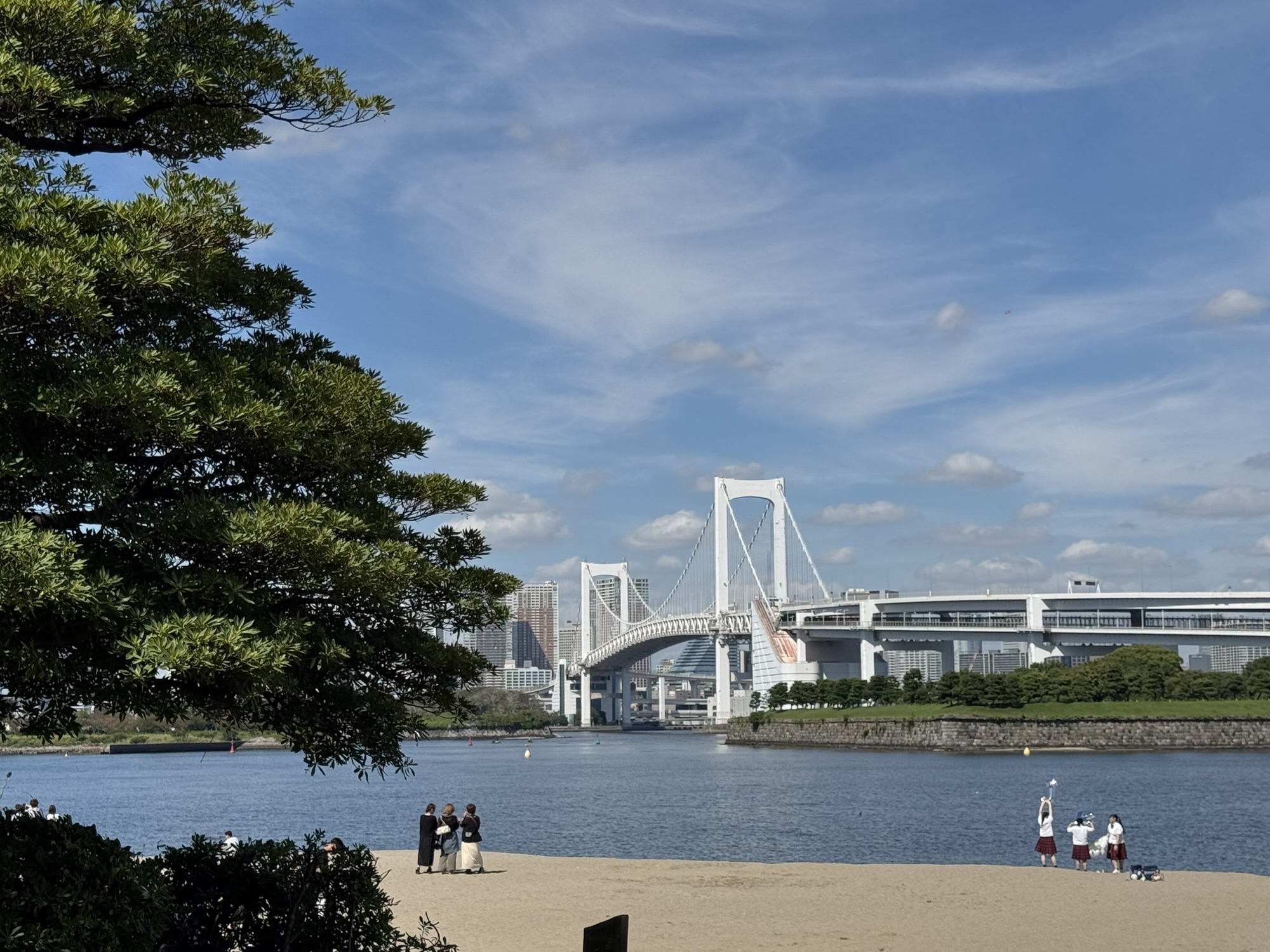
From Odaiba, I make my way to Rainbow Bridge, one of Tokyo’s most striking landmarks. Opened in 1993, the bridge stretches just under a mile across Tokyo Bay. It’s a suspension bridge painted a crisp white, looking elegant against both the city skyline by day and the dazzling city lights by night. The name Rainbow Bridge comes from its nighttime illumination with solar-powered lights that change color, creating a glowing gateway across the bay.
The bridge’s lower level incudes a pedestrian walkway – the North Route offers sweeping views of central Tokyo and the South Route opens onto the bay, Tokyo Tower, and even Mount Fuji on a clear day. Good luck with that wishful thinking.
Strolling across the water, I enjoy some of Tokyo’s best views, with the bonus of fresh sea air and only a couple other people. The traffic is heavy and noisy but the walk enjoyable. Like a pro, I catch the train at Shibaura-futō and ride the two stops home.
Returning to My Hood
After a whirlwind first day, I can safely say Tokyo exceeded every expectation—even the ones I didn’t know I had. I walked from Zen-like gardens where koi glided serenely under stone bridges and turtles lazed on rocks, to crowded train stations where I practiced my best confused-but-polite commuter impression. I strolled across the Rainbow Bridge, dodged selfie sticks at DiverCity, and stared up at 60-foot Gundam. My feet are begging for mercy.
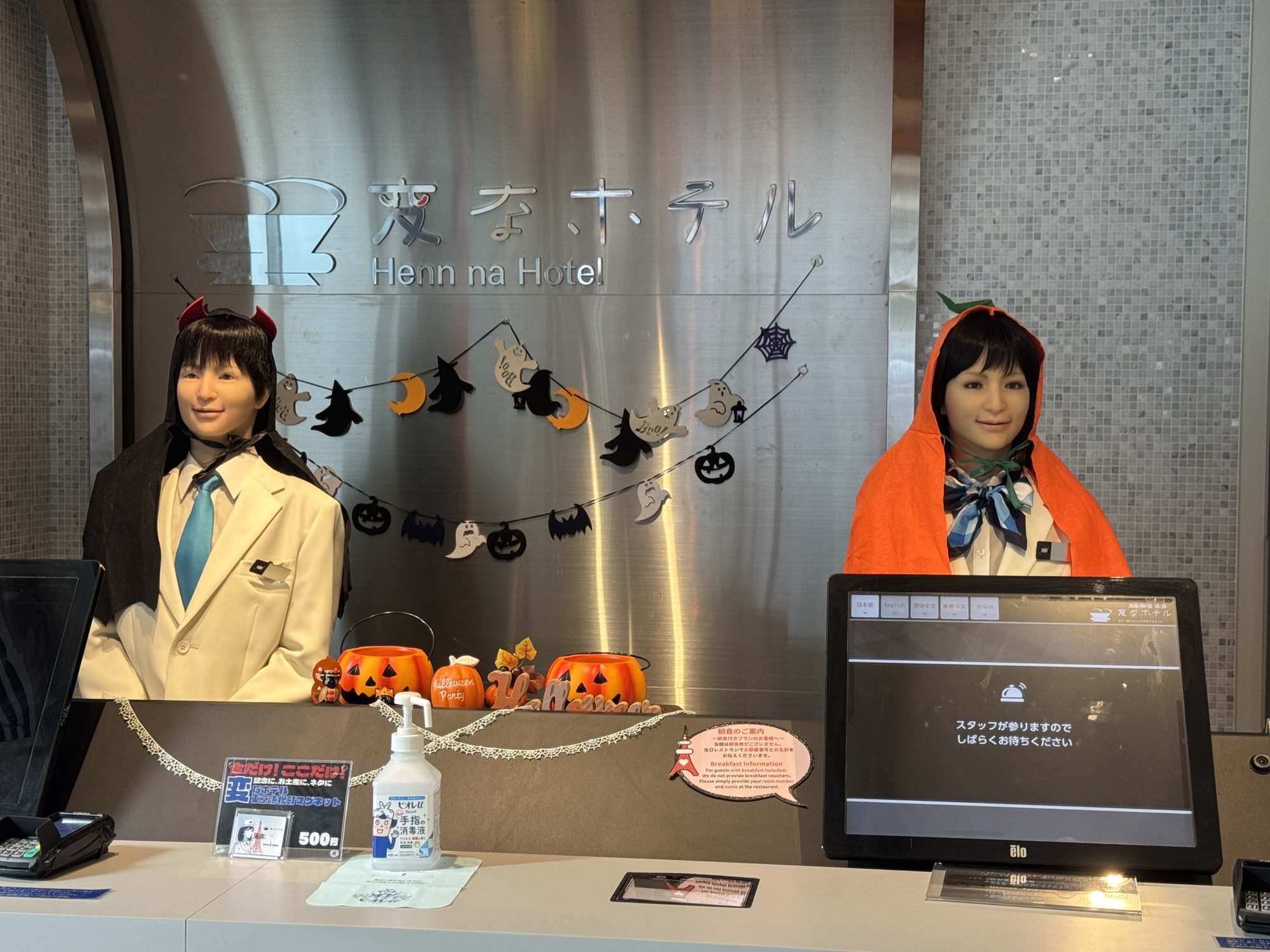
Stopping for a beer and some food at my neighborhood bar, I contemplate surviving my first day. Tokyo has proven to be a city that kept me on my toes, and I await how tomorrow tops Gundam.
0 Comments